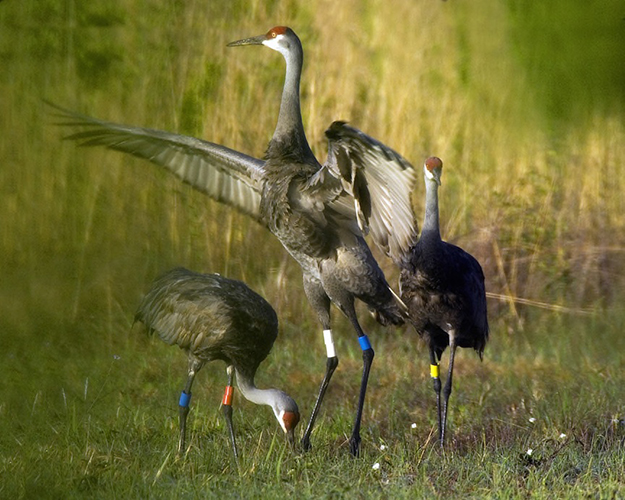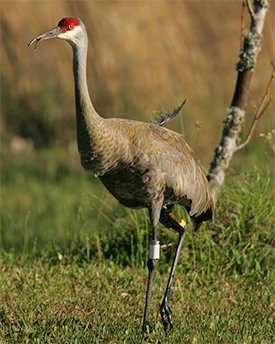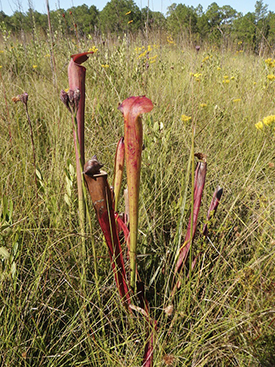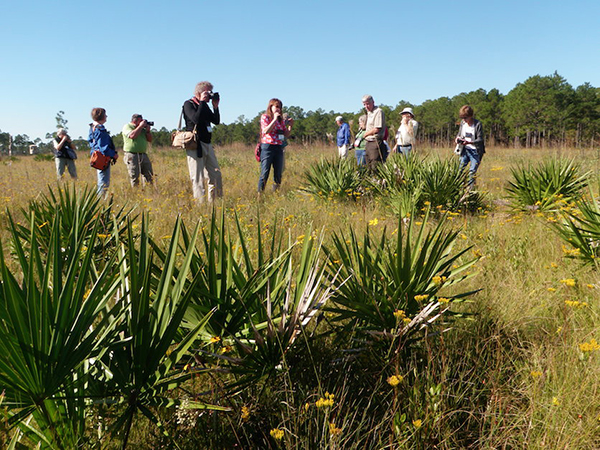GAUTIER, Miss. – You don’t have to be a dedicated birdwatcher to know you have a chance to see something extraordinary at the Mississippi Sandhill Crane National Wildlife Refuge. After all, there are only 129 of these long-legged, redheaded birds on the planet.
 The total population of Mississippi sandhill cranes is only 129 birds. Their sanctuary is a 19,000-acre national wildlife refuge. Image by U.S. Fish and Wildlife Service
The total population of Mississippi sandhill cranes is only 129 birds. Their sanctuary is a 19,000-acre national wildlife refuge. Image by U.S. Fish and Wildlife Service
|
|
The 19,000-acre refuge is in coastal Mississippi between Biloxi and Mobile, Ala. It was the first created for an endangered species, and it tells one of America’s greatest species recovery stories. When it was established in 1975, there were only 35 of the non-migratory cranes alive. They remain endangered, but hard work has more than tripled the population.
|
 Mississippi sandhill crane hatchlings can grow to four feet tall in just three months, and they start nesting at 3 to 5 years old. Image by U.S. Fish and Wildlife Service
Mississippi sandhill crane hatchlings can grow to four feet tall in just three months, and they start nesting at 3 to 5 years old. Image by U.S. Fish and Wildlife Service
|
|
The Nature Conservancy acquired the refuge’s core tract, preserving a small piece of the pine savanna habitat the cranes like. Wildlife biologist Scott Hereford takes small groups on van tours, and that increases your odds of seeing cranes. When I visited, I saw six cranes in a couple of hours, which is almost 5 percent of the total population. That’s a better winning percentage than I’d ever have at the nearby casinos in Biloxi.
The cranes nest in mounds about a yard across. If mating produces more than one egg, the second egg is taken for hatching at facilities in Maryland, Wisconsin or Louisiana. Hatchlings can grow to four feet tall in just three months, and they start nesting at 3 to 5 years old.
Of course, this habitat appeals to many other bird species such as yellow rails, redheaded woodpeckers, Henslow’s sparrows, LeConte’s sparrows (one of North America’s smallest sparrow species) and northern harriers. It’s possible to see more than 400 species in Mississippi, and almost all of them either reside in or pass through this coastal region.
The sandhill crane refuge has a second claim to fame. It is home to 12 species of carnivorous plants such as sundews, butterworts, bladderworts and four types of pitcher plants. On some patches of land, it’s just not safe being an insect.
|

Four types of pitcher plants are among 12 carnivorous plant species at the Mississippi Sandhill Crane National Wildlife Refuge. Image by Tom Adkinson |
|
You can learn even more about the region’s environment at the Pascagoula River Audubon Center at nearby Moss Point. It is key to understanding the 82-mile-long Pascagoula River, which the Nature Conservancy labels the largest (by volume) undammed river in the 48 contiguous states. Local lore calls it the “Singing River” because some visitors still hear the long-ago chants of the Pascagoula Indian tribe on quiet nights.
The Audubon Center offers kayak outings on Rhodes Bayou if you want some exercise and two-hour swamp and marsh tours on a pontoon boat if you just want to ride and look.
Yet another way to explore the Mississippi outdoors is with Capt. Kathy Wilkinson of Eco-Tours of South Mississippi in Gautier. She offers even longer Pascagoula River tours (two hours, four hours and full-day excursions into cypress swamps, salt marshes and even the barrier islands) and arranges marsh and swamp kayak trips. She also has a swamp cabin for six if you want an overnight experience.
Weather on the Mississippi coast is generally mild, making the region appealing for outdoor activities all year.
|
 Field trip participants at the Mississippi Sandhill Crane National Wildlife Refuge search for carnivorous plants. Image by Tom Adkinson
Field trip participants at the Mississippi Sandhill Crane National Wildlife Refuge search for carnivorous plants. Image by Tom Adkinson
|
|
Trip-planning resources: FWS.gov/refuge/mississippi_sandhill_crane, PascagoulaRiver.Audubon.org,
Eco-ToursOfSouthMississippi.com and GulfCoast.org

